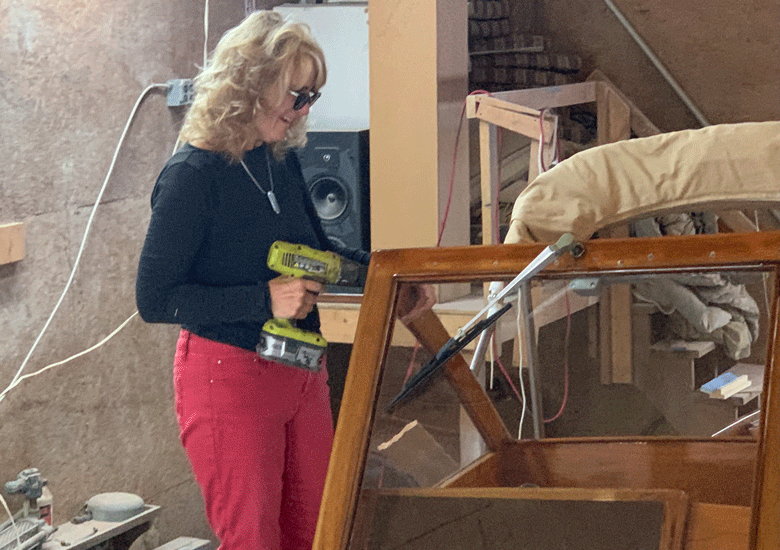Boatbuilder Kathy Walsh, who was diagnosed with a motor neuron disease called amyotrophic lateral sclerosis last spring, has developed strategies to continue working despite increasing weakness in her upper body.
Walsh also wonders if toxins found in work-related materials could be the cause of, or a contributor to the disease.
ALS, commonly called Lou Gehrig’s disease, is a fatal neurodegenerative disease affecting the motor nerves and voluntary muscles, according to the ALS Association. Symptoms include the spread of muscle weakness and paralysis through the body. People progressively lose the ability to move, talk, and even breathe and eat, although their minds remain sharp.
There are two types of ALS. “Sporadic” can affect anyone, anywhere and accounts for 90 to 95 percent of all cases. “Familial” means the disease is inherited.
She followed her doctor’s advice to start wearing a respirator during work.
A Mount Desert Island native, Walsh’s career started as a research assistant in animal reproduction labs in Colorado and California, followed by a 13-year stint at Jackson Laboratory in Bar Harbor.
She had also done side jobs on boats, mentored by her grandfather. Seventeen years ago, an opportunity came up to work for Carlton Johnson, founder of Redfern Boats, then located in Lamoine and now in Tremont. It meant a better salary than her lab gigs, so she went for it.
“It was just the two of us,” she said. “There have been a lot of projects along the way.”
About three years ago, Walsh began to experience weakness in her hands.
“They wouldn’t do what I wanted them to,” she said.
She saw a neurologist but was misdiagnosed for a long time.
MRIs indicated inflammation in her brain and toxicology tests indicated the inflammation was due to toxic exposure. She followed her doctor’s advice to start wearing a respirator during work.
But the weakness continued to spread and eventually she was diagnosed with ALS.
Today she has trouble speaking and swallowing. Her lower body remains strong and she can walk. But her upper body is weakening and she has a fair amount of muscle atrophy. She lost 30 pounds in recent months and her breathing is at only at 60 percent respiration.
“It feels like it’s advancing fairly quickly,” she said.
But she continues to work. That includes a lot of buffing, cleaning, varnishing, and painting
“I have issues with grip strength, so I have made some Velcro straps to hold sandpaper in my hands and used foam piping around my brushes and scrapers to help me grip them better,” she said.
A genetic test determined her ALS is not familial. So she’s been researching work-related toxins as possible triggers. Although studies are inconclusive, she wonders if long-term exposure to off-gassing related to pesticides found in imported teak or formaldehyde used in the manufacture of composite wood products might have triggered or contributed to her disease. Her work typically involves working with teak and wood and fiberglass composites.
A scientist at Jackson Laboratory said the causes of ALS are still unknown.
“ALS is a remarkably mysterious disease,” said Rob Burgess, who researches the genetics underlying neuromuscular and neurodevelopmental disorders.
ALS is more common than most people think—and it’s more than one disease, he explained.
“We talk about ALS as this monolith, but it’s not,” he said. “One of the challenges is that we don’t know if it’s ten different diseases, or 100 or a thousand different diseases.”
That makes it all the more difficult to determine possible environmental triggers.
“I’m sympathetic to people who want a cause or an explanation,” he said. “Everyone does, for any disease. It’s important to try to get that because if there is something causative out there, you want to minimize exposure. But it’s really challenging to do those kind of studies, especially for a disease where it’s hard to get tens or thousands of ALS patients together to do a large-scale epidemiological study.”
According to the ALS Association, there are currently four drugs approved by the U.S. FDA to treat ALS. Studies around the world are ongoing to develop more treatments and a cure.
Acknowledging the challenge of understanding and treating ALS, Walsh remains convinced on a personal level that better protection from off-gassing might have been key to the protection of her own health.
“I have three grandchildren and three more on the way,” she said. “I want to be around for them. I’m doing everything I can to fight this and to raise awareness.”





